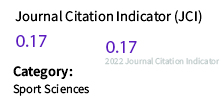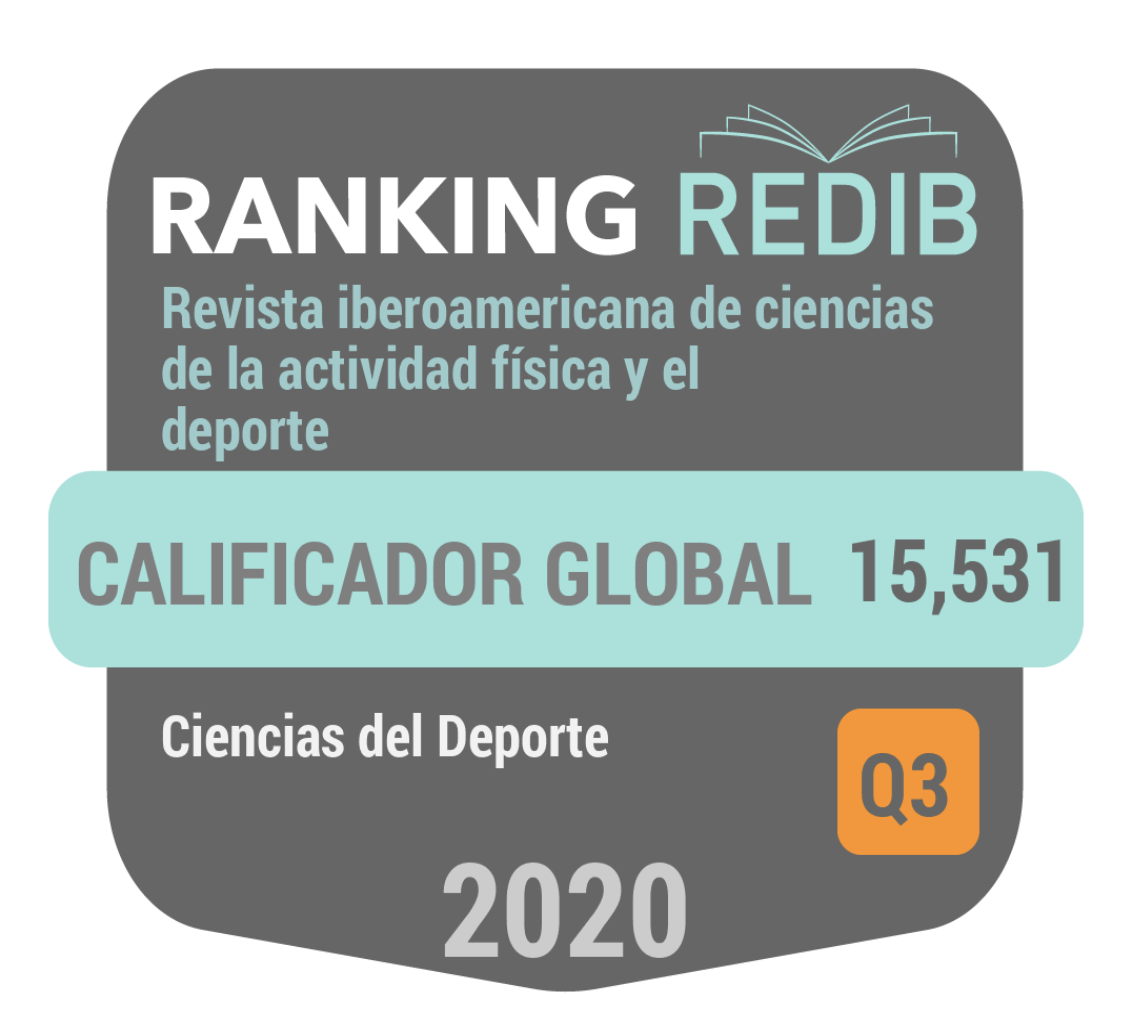Estatus de peso y condición física: revisión de la literatura científica
DOI:
https://doi.org/10.24310/riccafd.2017.v6i3.4850Palabras clave:
actividad física, condición física, estatus de peso, niños, adolescentesResumen
La relación entre obesidad y condición física es un fenómeno recientemente estudiado y cuyo origen es motivo de discusión. Esta revisión sistemática trata de realizar una síntesis de los artículos científicos publicados en los últimos años que analizan la relación entre estatus de peso y condición física. La búsqueda incluye artículos publicados entre 2.006 y 2.017, empleando para ello bases de datos electrónicas en inglés y español. Usando palabras clave como condición física, obesidad, estatus de peso, niños y adolescentes fueron incluidos artículos originales, artículos escritos en castellano o inglés, y estudios que incluían instrumentos de medida validados con anterioridad. En la primera búsqueda fueron hallados 159 artículos de los cuales un total de 16 artículos fueron seleccionados para la revisión. Los resultados obtenidos en estos artículos indican que la obesidad se asocia con una peor salud relacionada con la condición física.Descargas
Métricas
Citas
LaMonte MJ, Barlow CE, Jurca R, Kampert JB, Church TS, Blair SN. Cardiorespiratory fitness is inversely associated with the incidence of metabolic syndrome: a prospective study of men and women. Circulation. 2005; 112: 505-12.
Carnethon MR, Gidding SS, Nehgme R, Sidney S, Jacobs DR Jr, Liu K. Cardiorespiratory fitness in young adulthood and the development of cardiovascular disease risk factors. JAMA. 2003; 290: 3092-100.
Balady GJ. Survival of the fittest—more evidence. N Engl J Med. 2002; 346 (11): 852-4. 5.
Castillo MJ. Physical fitness is an important contributor to health for the adults of tomorrow. Selección. 2007; 17 (1): 2-8.
Gulati M, Pandey DK, Arnsdorf MF, Lauderdale DS, Thisted RA, Wicklund RH, et al. Exercise capacity and the risk of death in women: the St James Women Take Heart Project. Circulation. 2003; 108 (13): 1554-9.
Laukkanen JA, Lakka TA, Rauramaa R, Kuhanen R, Venalainen JM, Salonen R, et al. Cardiovascular fitness as a predictor of mortality in men. Arch Intern Med. 2001; 161(6): 825-31.
Rosa-Guillamón A. & García-Cantó E. (2016). Relationship between physical fitness and mental health in primary school children. Revista Iberoamericana de Ciencias de la Actividad Física y el Deporte. 2016; 5(2): 31-42.
Rosa-Guillamón A, García-Cantó E, Rodríguez-García PL, Pérez-Soto JJ. Weight status, physical fitness and satisfaction with life among elementary school children. a pilot study. (2016). Revista MHSalud. 2017; 13(2): 1-15.
Ruiz JR, Castro-Pinero J, Artero EG, Ortega FB, Sjostrom M, Suni J, Castillo MJ. Predictive validity of health-related fitness in youth: a systematic review. Br J Sports Med. 2009; 43(12): 909-923.
Kim J, Must A, Fitzmaurice GM, Gillman MW, Chomitz V, Kramer E, McGowan R, Peterson KE. Relationship of physical fitness to prevalence and incidence of overweight among schoolchildren. Obes Res. 2005; 13(7): 1246-54.
Mota J, Ribeiro JC, Carvalho J, Santos MP, Martins J. Cardiorespiratory fitness status and body mass index change over time: a 2-year longitudinal study in elementary school children. Int J Pediatr Obes. 2009; 4(4): 338-42.
Coelho-E-Silva MJ, Vaz Ronque ER, Cyrino ES, Fernandes RA, Valente-Dos-Santos J, Machado-Rodrigues A, Martins R, Figueiredo AJ, Santos R, Malina RM. Nutritional status, biological maturation and cardiorespiratory fitness in Azorean youth aged 11-15 years. BMC Public Health. 2013; 13: 495.
Rush E, McLennan S, Obolonkin V, Vandal, AC, Hamlin M, Simmons D, Graham D. Project Energize: whole-region primary school nutrition and physical activity programme; evaluation of body size and fitness 5 years after the randomised controlled trial. Br J Nutr. 2014; 111 (2): 363-371.
Mata J, Silva MN, Vieira PN, Carraça EV, Andrade AM, Coutinho SR, Teixeira PJ. Motivational “spill-over” during weight control: Increased self-determination and exercise intrinsic motivation predict eating self-regulation. Sport, Exercise, and Performance Psychology. 2011; 1(Suppl), 49-59.
Kozub FM. Motivation and Physical Activity in Adolescents With Visual Impairments: Review: Rehabilitation and Education for Blindness and Visual Impairment. 2006; 37 (4): 149-160.
Teixeira PJ, Going SB, Houtkooper LB, Cussler EC, Metcalfe LL, Blew RM & Lohman TG. Exercise motivation, eating, and body image variables as predictors of weight control. Medicine and Science in Sports and Exercise. 2006 38(1): 179-188.
Han JC, Lawlor DA, Kimm SY. Childhood obesity. The Lancet. 2010; 375 (9727): 1737-1748.
Klein D, De Toia D, Weber S, Wessely N, Koch B, Dordel S, Graf, C. Effects of a low threshold health promotion intervention on the BMI in pre-school children under consideration of parental participation. E-SPEN, the European e-Journal of Clinical Nutrition and Metabolism. 2010; 5 (3): e125-e131.
Rodríguez-Hernández A, Feu S, Martínez-Santos R, de la Cruz-Sánchez E. e-balonmano.com: Revista de Ciencias del Deporte. 2011; 7 (3): 157-168.
Chen LJ, Fox KR, Haase A, Wang JM. Obesity, fitness and health in Taiwanese children and adolescents. European Journal of Clinical Nutrition. 2006; 60: 1367–1375.
Cole TJ, Bellizzi MC, Flegal KM, Dietz WH. Establishing a standard definition for child overweight and obesity worldwide: international survey. British Medical Journal. 2000; 320: 1240-1243.
Casajús JA, Leiva MT, Villarroya A, Legaz A, Moreno LA. Physical performance and school physical education in overweight Spanish children. Ann Nutr Metab. 2007;51(3):28896.
Castro-Piñero J, González-Montesinos JL, Mora J, Keating XD, Ruiz J. Percentile values for muscular strength field tests in children aged 6 to 17 years: influence of weight status. Journal of Strength Cond Res. 2009; 23(8): 2295-310.
De la Cruz E, Pino J. (2010). Health-related physical fitness in schoolchildren and Spanish Physical Activity Guidelines. Cultura, Ciencia y Deporte. 2010; 5: 45-49.
Bratteby LE, Sandhagen B, Fan H, Samuelson G. A 7-day activity diary for assessment of daily energy expenditure validated by the doubly labelled water method in adolescents. European Journal of Clinical Nutrition. 1999; 51(9): 585-591.
Department of Health, Physical Activity, Health Improvement and Prevention. At least five a week: evidence on the impact of physical activity and its relationship to health. A report from the Chief Medical Officer. London: Department of Health; 2004.
García-Artero EG, España-Romero V, Ortega FB, Jiménez-Pavón D, Ruiz JR, Vicente-Rodríguez G, Bueno M, Marcos A, Gómez-Martínez S, Urzanqui A, González-Gross M, Moreno LA, Gutiérrez A, Castillo MJ. Health-related fitness in adolescents: underweight, and not only overweight, as an influencing factor. The AVENA study. Scandinavian Journal of Medicine & Science in Sports. 2010; 20: 418-427.
Maestre JM. Connection between nutritional state and physical fitness in schoolar population. Journal of Sport and Health Research. 2010; 2(2), 95-108.
Joshi P, Bryan C, Howat H. Relationship of body mass index and fitness levels among schoolchildren. J Strength Cond Res. 2012; 26 (4): 1006-14.
Cooper Institute for Aerobics Research. FITNESSGRAM Test Administrator's Manual, 2nd. Ed. Champaign, Il: Human Kinetics; 1999.
Castro-Piñero J, Mora J, González-Montesinos JS, Ortega FB, Keating XD, Sjöström M, Ruiz RJ. Percentile values for cardiorespiratory fitness running/walking field tests in children aged 6 to 17 years. Nutr Hosp. 2011; 26(3): 572-578.
Mayorga-Vega D, Brenes-Podadera A, Rodríguez-Tejero M, Merino-Marban R. Association of BMI and physical fitness level among elementary school students. Journal of Sport and Health Research. 2012; 4(3): 299-310.
Arriscado D, Dalmau JM, Muros JJ, Zabala M. Relación entre condición física y composición corporal en escolares de primaria del norte de España. Nutr Hosp. 2014; 30(2): 385-394.
Ruiz JR, España Romero V, Castro Piñero J, Artero EG, Ortega FB, Cuenca García, M, et al. Batería ALPHA-Fitness: test de campo para la evaluación de la condición física relacionada con la salud en niños y adolescentes. Nutr Hosp. 2011; 26 (6): 1210-1214.
Rosa A, García-Cantó E, Rodríguez-García PL, Pérez-Soto JJ. Nivel de capacidad aeróbica y su relación con el estatus corporal en escolares de 8 a 12 años. EmásF, Revista Digital de Educación Física. 2014; 6(31): 7-20.
Gálvez A, Rodríguez-García PL, Rosa A, García-Cantó E, Pérez-Soto JJ, Tárraga ML, Tárraga PJ. Nivel de condición física y su relación con el estatus de peso corporal en escolares. Nutr Hosp. 2015; 31(1): 393-400.
Rosa A, Rodríguez-García PL, García-Cantó E, Pérez-Soto JJ. Niveles de condición física de escolares de 8 a 11 años en relación al género y a su estatus corporal. Ágora para la EF y el Deporte. 2015; 17(3): 237-250.
Neri M, Bargossi A. Alimentación y ciclismo. Bilbao: Dorleta. 2000.
Pacheco-Herrera JD, Ramírez-Vélez R, Correa-Bautista JE. Índice general de fuerza y adiposidad como medida de la condición física relacionada con la salud en niños y adolescentes de Bogotá, Colombia: Estudio FUPRECOL. Nutr Hosp. 2016;33: 556-564
Lema L, Mantilla SC, Arango CM. Associations Between Physical Fitness and Adiposity Among School-Age Children from Monteria, Colombia. Rev int med cienc act fís deporte. 2016; 16(62): 277-296.
Muros JJ, Cofre-Bolados C, Salvador-Pérez, S, Castro-Sánchez M, Valdivia-Moral P, Pérez-Cortés A.J. (2016). Relación entre nivel de actividad física y composición corporal en escolares de Santiago (Chile). Journal of Sport and Health Research. 2016; 8(1):65-74.
Slaughter, M.H., Lohman, T.G., Boileau, R.A., Stillman, P.J., Van Loan, M.D., Bembem, D.A. (1988). Skinfolds equations for estimation of body fatness in children and youth. Human Biology. 60(5), 709-723.
Martínez-Gómez D, Martínez-De-Haro V, Pozo T, Welk GJ, Villagra A, Calle ME, Valcarce-Sánchez E. Reliability and validity of the PAQ-A questionnaire to assess physical activity in Spanish adolescents. Revista Española de Salud Pública. 2009; 83(3): 427-439.
Goran M, Fields DA, Hunter GR, Herd SL, Weinsier RL. Total body fat does not influence maximal aerobic capacity. Int J Obes Relat Metab Disord. 2000; 24: 841-8.
Mota J, Guerra S, Leandro C, Pinto A, Ribeiro JC, Duarte JA. Association of maturation, sex, and body fat in cardiorespiratory fitness. Am J Hum Biol. 2002; 14:707-12.
McAuley PA, Blair SN. Obesity paradoxes. Journal of Sports Sciences. 2011; 29(8); 773-782.
Descargas
Publicado
Cómo citar
Número
Sección
Licencia
Todos los contenidos publicados en Revista Iberoamericana de Ciencias de la Actividad Física y el Deporte están sujetos a la licencia Creative Commons Reconocimento-NoComercia-Compartirigual 4.0 cuyo texto completo puede consultar en <http://creativecommons.org/licenses/by-nc-sa/4.0>

Se pueden copiar, usar, difundir, transmitir y exponer públicamente, siempre que:
- Se cite la autoría y la fuente original de su publicación (revista, editorial y URL de la obra).
- No se usen para fines comerciales.
- Se mencione la existencia y especificaciones de esta licencia de uso.
Los derechos de autor son de dos clases: derechos morales y derechos patrimoniales. Los derechos morales son prerrogativas perpetuas, irrenunciables, intransferibles, inalienables, inembargables e imprescriptibles.
De acuerdo con la legislación de derechos de autor, Revista Iberoamericana de Ciencias de la Actividad Física y el Deporte reconoce y respeta el derecho moral de los autores/as, así como la titularidad del derecho patrimonial, el cual será cedido a la Universidad de Málaga para su difusión en acceso abierto.
Los derechos patrimoniales, se refieren a los beneficios que se obtienen por el uso o divulgación de las obras. Revista Iberoamericana de Ciencias de la Actividad Física y el Deporte se publica en open access y queda autorizada en exclusiva para realizar u autorizar por cualquier medio el uso, distribución, divulgación, reproducción, adaptación, traducción o transformación de la obra.
Es responsabilidad de los autores/as obtener los permisos necesarios de las imágenes que están sujetas a derechos de autor.






.png)








9.png)
